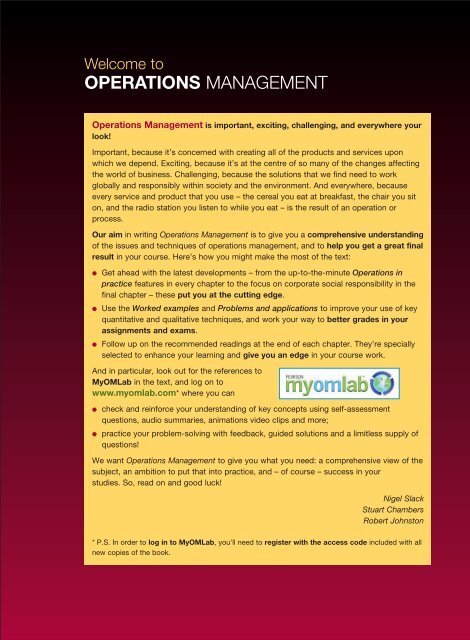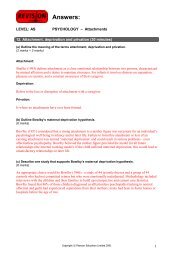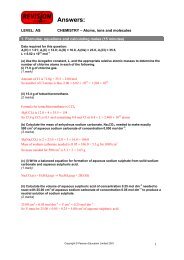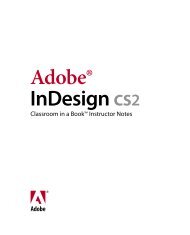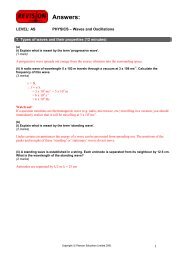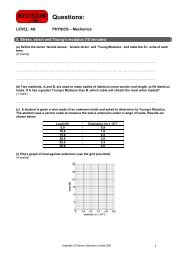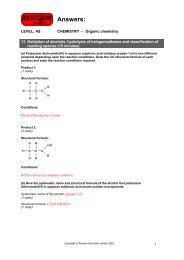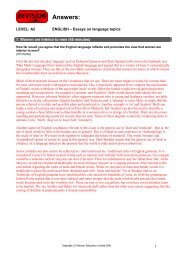OPERATIONS MANAGEMENT - Pearson
OPERATIONS MANAGEMENT - Pearson
OPERATIONS MANAGEMENT - Pearson
- No tags were found...
Create successful ePaper yourself
Turn your PDF publications into a flip-book with our unique Google optimized e-Paper software.
ContentsGuide to ‘operations in practice’, examples,short cases and case studiesMaking the most of this book and MyOMLabPrefaceTo the InstructorTo the StudentTen steps to getting a better grade inoperations managementAbout the authorsAcknowledgementsxixivxviiixxxxixxiixxiiixxivPart OneINTRODUCTION 1Chapter 1Operations management 2Introduction 2What is operations management? 4Operations management is important inall types of organization 6The input–transformation–output process 11The process hierarchy 15Operations processes have differentcharacteristics 19The activities of operations management 23Summary answers to key questions 25Case study: Design house partnerships atConcept Design Services 27Problems and applications 30Selected further reading 30Useful web sites 31Chapter 2Operations performance 32Introduction 32Operations performance is vital for anyorganization 34The quality objective 40The speed objective 42The dependability objective 44The flexibility objective 46The cost objective 48Trade-offs between performance objectives 54Summary answers to key questions 56Case study: Operations objectives atthe Penang Mutiara 57Problems and applications 58Selected further reading 59Useful web sites 59Chapter 3Operations strategy 60Introduction 60What is strategy and what is operations strategy? 62The ‘top-down’ and ‘bottom-up’ perspectives 65The market requirements and operationsresources perspectives 68The process of operations strategy 75Summary answers to key questions 79Case study: Long Ridge Gliding Club 80Problems and applications 81Selected further reading 82Useful web sites 82Part TwoDESIGN 85Chapter 4Process design 86Introduction 86What is process design? 87What effects should process design have? 88Process types – the volume–variety effect onprocess design 91Detailed process design 96Summary answers to key questions 108Case study: The Central Evaluation Unit 109Problems and applications 110Selected further reading 111Useful web sites 111Chapter 5The design of products and services 112Introduction 112Why is good design so important? 114The benefits of interactive design 129Summary answers to key questions 134Case study: Chatsworth – the adventureplayground decision 135Problems and applications 136Selected further reading 137Useful web sites 137
viiiContentsChapter 6Supply network design 138Introduction 138The supply network perspective 140Configuring the supply network 142The location of capacity 146Long-term capacity management 155Summary answers to key questions 161Case study: Disneyland Resort Paris (abridged) 162Problems and applications 166Selected further reading 167Useful web sites 167Supplement to Chapter 6Forecasting 168Introduction 168Forecasting – knowing the options 168In essence forecasting is simple 169Approaches to forecasting 170Selected further reading 176Chapter 7Layout and flow 177Introduction 177What is layout? 179The basic layout types 180What type of layout should an operationchoose? 187Detailed design of the layout 189Summary answers to key questions 202Case study: Weldon Hand Tools 203Problems and applications 204Selected further reading 205Useful web sites 205Chapter 8Process technology 206Introduction 206What is process technology? 208Understanding process technologies 209Evaluating process technologies 221Implementing process technologies 227Summary answers to key questions 229Case study: Rochem Ltd 230Problems and applications 232Selected further reading 232Useful web sites 232Chapter 9People, jobs and organization 233Introduction 233People in operations 235Human resource strategy 236Organization design 238Job design 241Summary answers to key questions 255Case study: Service Adhesives tries again 256Problems and applications 257Selected further reading 258Useful web sites 258Supplement to Chapter 9Work study 259Introduction 259Method study in job design 259Work measurement in job design 262Part ThreePLANNING AND CONTROL 267Chapter 10The nature of planning and control 268Introduction 268What is planning and control? 270Supply and demand affect planning and control 272Planning and control activities 277Summary answers to key questions 293Case study: Air traffic control – a world-classjuggling act 294Problems and applications 295Selected further reading 296Useful web sites 296Chapter 11Capacity planning and control 297Introduction 297What is capacity management? 299Measuring demand and capacity 301The alternative capacity plans 309Choosing a capacity planning and controlapproach 317Capacity planning as a queuing problem 322Summary answers to key questions 327Case study: Holly Farm 328Problems and applications 331Selected further reading 332Useful web sites 332Supplement to Chapter 11Analytical queuing models 333Introduction 333Notation 333Variability 334Incorporating Little’s law 335Types of queuing system 336
ContentsixChapter 12Inventory planning and control 340Introduction 340What is inventory? 342Why is inventory necessary? 342Some disadvantages of holding inventory 345The volume decision – how much to order 346The timing decision – when to place an order 357Inventory analysis and control systems 362Summary answers to key questions 368Case study: Trans-European Plastics 369Problems and applications 371Selected further reading 371Useful web sites 372Chapter 13Supply chain planning and control 373Introduction 373What is supply chain management? 375The activities of supply chain management 377Types of relationships in supply chains 386Supply chain behaviour 391Supply chain improvement 394Summary answers to key questions 400Case study: Supplying fast fashion 401Problems and applications 404Selected further reading 405Useful web sites 405Chapter 14Enterprise resource planning (ERP) 406Introduction 406What is ERP? 408How did ERP develop? 408Implementation of ERP systems 415Summary answers to key questions 417Case study: Psycho Sports Ltd 418Problems and applications 420Selected further reading 421Useful web sites 421Supplement to Chapter 14Materials requirements planning(MRP) 422Introduction 422Master production schedule 422The bill of materials (BOM) 424Inventory records 425The MRP netting process 425MRP capacity checks 428Summary 428Chapter 15Lean synchronization 429Introduction 429What is lean synchronization? 431Eliminate waste 435Lean synchronization applied throughoutthe supply network 447Lean synchronization and other approaches 449Summary answers to key questions 452Case study: Boys and Boden (B&B) 453Problems and applications 455Selected further reading 456Useful web sites 456Chapter 16Project planning and control 457Introduction 457What is a project? 459Successful project management 461The project planning and control process 462Network planning 475Summary answers to key questions 487Case study: United Photonics Malaysia Sdn Bhd 488Problems and applications 493Selected further reading 494Useful web sites 494Chapter 17Quality management 495Introduction 495What is quality and why is it so important? 497Diagnosing quality problems 501Conformance to specification 502Total quality management (TQM) 508Summary answers to key questions 515Case study: Turnround at the Preston plant 516Problems and applications 518Selected further reading 519Useful web sites 519Supplement to Chapter 17Statistical process control (SPC) 520Introduction 520Control charts 520Variation in process quality 521Control charts for attributes 527Control chart for variables 528Process control, learning and knowledge 532Acceptance sampling 533Sampling plans 533Summary 535Selected further reading 536Useful web sites 536
xContentsPart FourIMPROVEMENT 539Chapter 18Operations improvement 540Introduction 540Why improvement is so important 542Elements of improvement 542Approaches to improvement 549Improvement techniques 558Summary answers to key questions 564Case study: Geneva Constructionand Risk 565Problems and applications 569Selected further reading 570Useful web sites 570Chapter 19Risk management 571Introduction 571What is risk management? 573Assess the potential causes of and risksfrom failure 573Preventing failure occurring 586Mitigating the effects of failure 592Recovering from the effects of failure 593Summary answers to key questions 596Case study: The Chernobyl failure 597Problems and applications 599Selected further reading 600Useful web sites 600Chapter 20Organizing for improvement 601Introduction 601Why the improvement effort needs organizing 603Linking improvements to strategy 603Information for improvement 606Improvement priorities – what to start on? 612Improvement culture 617Implementing improvement 620Summary answers to key questions 624Case study: Re-inventing Singapore’s libraries 626Problems and applications 628Selected further reading 628Useful web sites 629Part FiveCORPORATE SOCIAL RESPONSIBILITY 631Chapter 21Operations and corporate socialresponsibility (CSR) 632Introduction 632What is corporate social responsibility? 633How does the wider view of corporate socialresponsibility influence operationsmanagement? 637How can operations managers analyse CSRissues? 646Summary answers to key questions 648Case study: CSR as it is presented 649Problems and applications 650Selected further reading 651Useful web sites 651Notes on chapters 652Glossary 658Index 670
Guide to ‘operations in practice’, examples,short cases and case studiesChapter Location Company/example Region Sector/activity Company sizeChapter 1 p. 3 IKEA Global Retail LargeOperations p. 8 Acme Whistles UK Manufacturing Smallmanagement p. 9 Oxfam Global Charity Largep. 14 Prêt A Manger Europe/USA Retail Mediump. 21 Formule 1 Europe Hospitality Largep. 21 Mwagusi Safari Lodge Tanzania Hospitality Smallp. 27 Concept Design Services UK Design/manufacturing/ MediumdistributionChapter 2 p. 33 A tale of two terminals Dubai and UK Transport LargeOperations p. 41 Lower Hurst Farm UK Agricultural Smallperformance p. 43 Accident recovery General Healthcare Mediump. 44 Dabbawalas hit 99.9999% India General service Largedependabilityp. 47 BBC Global Media Largep. 49 Aldi Europe Retail Largep. 51 Hon Hai Precision Industry Taiwan/China Manufacturing Largep. 57 Mutiara Beach Resort, Penang Malaysia Hospitality MediumChapter 3 p. 61 Two operations strategies: Global/Europe Manufacturing service/ LargeOperations Flextronics and Ryanair transportstrategy p. 68 Giordano Asia Retail Largep. 74 Amazon what exactly is your Global Retail/business Largecore competence?servicesp. 77 Sometimes any plan is better Europe Military Largethan no planp. 80 Long Ridge Gliding Club UK Sport SmallChapter 4 p. 87 McDonalds USA Quick service LargeProcess design p. 90 Daimler-Chrysler, Smart car France Auto manufacturing Largep. 107 Heathrow UK Transport Largep. 109 The Central Evaluation Unit Belgium Non-governmental Large(European Union Directorate)organizationChapter 5 p. 113 Airbus A380 Europe Aerospace LargeThe design of p. 116 Dyson Global Design/manufacturing Largeproducts and p. 120 Square water melons Japan Retail/Agriculture Variousservices p. 122 Daniel Hersheson UK Hairdressing Smallp. 125 Art Attack! UK Media Smallp. 135 Chatsworth House UK Tourism MediumChapter 6 p. 139 Dell Global Computer LargeSupply networkmanufacturingdesign p. 145 Hon Hai, Quanta and Compal Taiwan Computer Largemanufacturingp. 147 Tata Nano India Manufacturing Largep. 149 Tesco Thailand Retail Largep. 151 High-tech subcontracting India/China Research and Medium/largedevelopmentp. 162 Disneyland Paris France Entertainment Large
xiiGuide to ‘operations in practice’, examples, short cases and case studiesChapter Location Company/example Region Sector/activity Company sizeChapter 7 p. 178 Tesco Global Retail LargeLayout and flow p. 180 Surgery UK Healthcare Mediump. 185 Yamaha Japan Piano manufacturing Largep. 186 Cadbury UK Entertainment and Largemanufacturingp. 203 Weldon Hand Tools UK Manufacturing LargeChapter 8 p. 207 Airlines All Airlines LargeProcess p. 210 Robots All Security Varioustechnology p. 211 Yo! Sushi UK Restaurants Mediump. 213 IBM USA Disaster recovery Largep. 218 Farming Netherlands Agriculture Mediump. 220 QB House Asia Hairdressing Mediump. 224 SVT (Sveriges Television) Sweden Media Largep. 230 Rochem Ltd UK Food processing MediumChapter 9 p. 234 W.L. Gore and Associates Global Manufacturing and LargePeople, jobsresearchand p. 237 Google Global e-services Largeorganization p. 247 McDonalds UK Restaurants Largep. 250 Lloyds TSB Europe Banking Largep. 256 Service Adhesives Europe Manufacturing LargeChapter 10 p. 269 BMW dealership UK Service and repair MediumThe nature of p. 273 Air France Global Airline Largeplanning and p. 281 Accident and Emergency All Healthcare Largecontrol p. 286 Chicken salad sandwich All Food processing Large(Part 1)p. 292 Robert Wiseman Dairies UK Milk distribution Largep. 294 Air traffic control All Air travel MediumChapter 11 p. 298 Britvic Europe Distribution LargeCapacity p. 304 Seasonal products and services All Various Variousplanning p. 309 British Airways London Eye UK Tourism Mediumand control p. 310 Lettuce growing Europe Agriculture Largep. 315 Seasonal products and services UK/Global Food processing/media Largep. 317 Greetings cards All Design Largep. 326 Madame Tussauds, Amsterdam Netherlands Tourism Mediump. 328 Holly Farm UK Agriculture/ SmallentertainmentChapter 12 p. 341 UK National Blood Service UK Healthcare LargeInventory p. 348 Croft Port Europe Beverages Largeplanning and p. 356 The Howard Smith Paper Group UK Distribution service Largecontrol p. 369 Trans-European Plastic France Manufacturing LargeChapter 13 p. 374 Siemens Europe Service and LargeSupply chainmanufacturingplanning and p. 379 Ford Motor Company Global Auto manufacturing Largecontrol p. 384 Levi Straus & Co Global Garment design/ Largeretailingp. 385 TDG Europe Logistics services Largep. 397 Northern Foods Europe Food services Largep. 398 Seven-Eleven Japan Japan Retail Largep. 401 H&M, Benetton and Zara Global Design/manufacturing/ Largedistribution/retail
Guide to ‘operations in practice’, examples, short cases and case studiesxiiiChapter Location Company/example Region Sector/activity Company sizeChapter 14 p. 407 Rolls Royce Global Aerospace LargeEnterprise p. 410 SAP Global IT services LargeResource p. 411 Chicken salad sandwich All Food processing SmallPlanning (Part 2)p. 414 SAP Global IT services Largep. 417 What a waste US Waste management Largep. 418 Psycho Sports Ltd All Manufacturing SmallChapter 15 p. 430 Toyota Motor Company Global Auto manufacturing LargeLean p. 440 Hospitals UK Healthcare Medium/largesynchronizationChapter 16 p. 458 The Millau Bridge France Construction LargeProject p. 465 The National Trust UK Heritage Variousplanning p. 47 Access HK Hong Kong Charity Smalland control p. 488 United Photonics Malaysia Malaysia Research and MediumSdn BhddevelopmentChapter 17 p. 496 Four Seasons Hotel Global/UK Hospitality LargeQuality p. 499 Tea and Sympathy USA Hospitality Smallmanagement p. 500 Magic Moments UK Photography services Smallp. 505 Vitacress Europe Agriculture Largep. 507 Surgical Statistics US Healthcare Variousp. 512 IBM Canada IT services Largep. 516 Rendall Graphics Canada Manufacturing MediumChapter 18 p. 541 Heineken International (Part I) Netherlands Brewery LargeImprovement p. 548 Erdington UK Beverage Largep. 556 Xchanging Europe Process outsourcing Largep. 565 Geneva Construction and Europe Insurance LargeRisk (GCR)Chapter 19 p. 572 Cadburys Salmonella outbreak Global Confectionary LargeRisk p. 575 Not what you want to hear USA Airline Largemanagement p. 577 Viruses, threats and 30 years Global Internet Variousof spamp. 592 Otis Elevators Global Facilities services Largep. 597 Chernobyl Ukraine Power generation LargeChapter 20 p. 602 Taxing Quality Denmark Public service LargeOrganizing for p. 620 Heineken International (Part II) Netherlands Brewery Largeimprovement p. 622 Work-Out at GE Global Various ?Largep. 626 Singapore Libraries Singapore ? ?Chapter 21 p. 635 Ecological footprints All All AllCorporate p. 638 HP Recycling Program Global Manufacturing Largesocial p. 642 The Gap between perception, Global Retail Largeresponsibilityreality and intention(CSR) p. 649 CSR as it is presented Various Various Various
Making the most of this book and MyOMLabCheck your understandingEach chapter opens with a set of Key questions to identify major topics. Summary answers concludethe chapter. You can check your understanding of each chapter by taking the Sample tests ofself-assessment questions on MyOMLab at www.myomlab.com.Chapter 2Operations performance56Part One IntroductionSummary answers to key questionsCheck and improve your understanding of this chapter using self assessment questionsand a personalised study plan, audio and video downloads, and an eBook – all atwww.myomlab.com.Key questions➤ Why is operations performanceimportant in any organization?➤ How does the operations functionincorporate all stakeholders’objectives?➤ What does top management expectfrom the operations function?➤ What are the performanceobjectives of operations andwhat are the internal and externalbenefits which derive from excellingin each of them?➤ How do operations performanceobjectives trade off against eachother?IntroductionOperations are judged by the way they perform. There aremany individuals and groups doing the judging and thereare many different aspects of performance on which theassessment is being made. The people doing the judging arecalled ‘stakeholders’ and the aspects of performance theyare using are called ‘performance objectives’. And if we wantto understand the strategic contribution of the operationsfunction, it is important to understand how we can measureits performance. So this chapter starts by illustrating howoperations performance can impact on the success of thewhole organization. Second, we look at various perspectiveson, and aspects of performance. Finally, we examine howperformance objectives trade off against each other. On ourgeneral model of operations management the topics covered inthis chapter are represented by the area marked on Figure 2.1.➤ Why is operations performance important in any organization?■ Operations management can either ‘make or break’ any business. It is large and, in most businesses,represents the bulk of its assets, but also because the operations function gives theability to compete by providing the ability to respond to customers and by developing thecapabilities that will keep it ahead of its competitors in the future.➤ How does the operations function incorporate all stakeholders objectives?■ At a strategic level, performance objectives relate to the interests of the operation’s stakeholders.They relate to the company’s responsibility to customers, suppliers, shareholders,employees, and society in general.➤ What does top management expect from the operations function?■ Operations can contribute to the organization as a whole by:– reducing the costs– achieving customer satisfaction– reducing the risk of operational failure– reducing the amount of investment– providing the basis for future innovation.➤ What are the performance objectives of operations and what are the internaland external benefits which derive from excelling in each of them?Figure 2.1 This chapter examines operations performanceCheck and improve your understanding of this chapter using self assessmentquestions and a personalised study plan, audio and video downloads, and aneBook – all at www.myomlab.com.■ By ‘doing things right’, operations seek to influence the quality of the company’s goods andservices. Externally, quality is an important aspect of customer satisfaction or dissatisfaction.Internally, quality operations both reduce costs and increase dependability.■ By ‘doing things fast’, operations seek to influence the speed with which goods and servicesare delivered. Externally, speed is an important aspect of customer service. Internally, speedboth reduces inventories by decreasing internal throughput time and reduces risks by delayingthe commitment of resources.■ By ‘doing things on time’, operations seek to influence the dependability of the delivery of goodsand services. Externally, dependability is an important aspect of customer service. Internally,dependability within operations increases operational reliability, thus saving the time and moneythat would otherwise be taken up in solving reliability problems and also giving stability to theoperation.■ By ‘changing what they do’, operations seek to influence the flexibility with which the companyproduces goods and services. Externally, flexibility can:– produce new products and services (product/service flexibility);– produce a wide range or mix of products and services (mix flexibility);– produce different quantities or volumes of products and services (volume flexibility);– produce products and services at different times (delivery flexibility).
PrefaceIntroductionOperations management is important. It is concernedwith creating the services and products upon which weall depend. And all organizations produce some mixtureof services and products, whether that organization islarge or small, manufacturing or service, for profit ornot for profit, public or private. Thankfully, most companieshave now come to understand the importanceof operations. This is because they have realized thateffective operations management gives the potential toimprove both efficiency and customer service simultaneously.But more than this, operations management iseverywhere, it is not confined to the operations function.All managers, whether they are called Operations orMarketing or Human Resources or Finance, or whatever,manage processes and serve customers (internalor external). This makes, at least part of their activities‘operations’.Operations management is also exciting. It is at thecentre of so many of the changes affecting the businessworld – changes in customer preference, changes insupply networks brought about by internet-basedtechnologies, changes in what we want to do at work,how we want to work, where we want to work, andso on. There has rarely been a time when operationsmanagement was more topical or more at the heart ofbusiness and cultural shifts.Operations management is also challenging. Promotingthe creativity which will allow organizations torespond to so many changes is becoming the primetask of operations managers. It is they who must findthe solutions to technological and environmentalchallenges, the pressures to be socially responsible, theincreasing globalization of markets and the difficult-todefineareas of knowledge management.The aim of this bookThis book provides a clear, authoritative, well structuredand interesting treatment of operations management asit applies to a variety of businesses and organizations.The text provides both a logical path through the activitiesof operations management and an understandingof their strategic context.More specifically, this text is:●●●●●●Strategic in its perspective. It is unambiguous intreating the operations function as being central tocompetitiveness.Conceptual in the way it explains the reasons whyoperations managers need to take decisions.Comprehensive in its coverage of the significant ideasand issues which are relevant to most types ofoperation.Practical in that the issues and challenges of makingoperations management decisions in practice arediscussed. The ‘Operations in practice’ feature, whichstarts every chapter, the short cases that appearthrough the chapters, and the case studies at the endof each chapter, all explore the approaches takenby operations managers in practice.International in the examples which are used. Thereare over 120 descriptions of operations practice fromall over the world.Balanced in its treatment. This means we reflect thebalance of economic activity between service andmanufacturing operations. Around seventy-five percent of examples are from service organizations andtwenty-five percent from manufacturing.Who should use this book?Anyone who is interested in how services and productsare created.●●●Undergraduates on business studies, technical orjoint degrees should find it sufficiently structured toprovide an understandable route through the subject(no prior knowledge of the area is assumed).MBA students should find that its practical discussionsof operations management activities enhancetheir own experience.Postgraduate students on other specialist mastersdegrees should find that it provides them with a wellgroundedand, at times, critical approach to the subject.Distinctive featuresClear structureThe structure of the book uses a model of operationsmanagement which distinguishes between design, planningand control, and improvement.
PrefacexixIllustrations-basedOperations management is a practical subject and cannotbe taught satisfactorily in a purely theoretical manner.Because of this we have used examples and ‘boxed’ shortcases which explain some issues faced by real operations.Worked examplesOperations management is a subject that blends qualitativeand quantitative perspectives; ‘worked examples’are used to demonstrate how both types of techniquecan be used.Critical commentariesNot everyone agrees about what is the best approachto the various topics and issues with operations management.This is why we have included ‘critical commentaries’that pose alternative views to the one beingexpressed in the main flow of the text.Summary answers to key questionsEach chapter is summarized in the form of a list of bulletpoints. These extract the essential points which answerthe key question posed at the beginning of each chapter.Case studiesEvery chapter includes a case study suitable for classdiscussion. The cases are usually short enough to serveas illustrations, but have sufficient content also to serveas the basis of case sessions.Problems and applicationsEvery chapter includes a set of problem type exercises.These can be used to check out your understandingof the concepts illustrated in the worked examples.There are also activities that support the learningobjectives of the chapter that can be done individuallyor in groups.Selected further readingEvery chapter ends with a short list of further readingwhich takes the topics covered in the chapter further, ortreats some important related issues. The nature of eachfurther reading is also explained.Useful websitesA short list of web addresses is included in each chapterfor those who wish to take their studies further.
To the Instructor …Teaching and learning resources for the 6th editionNew for the sixth editionWe have a regular opportunity to listen to the views ofusers of the book and are always keen to receive feedback.Our research for the 6th edition resulted in maintainingthe successful structure of previous editions and incorporatingthe following key changes:●●●●●An even greater emphasis has been placed on the ideaof ‘process management’, making the subject morerelevant to every functional areas of the organization.A whole new chapter on Corporate Social Responsibility(CSR) has been added, and reflects a greateremphasis on this issue throughout the book.The ‘Operations in Practice’ sections that are used tointroduce the topic at the beginning of each chapterhave been refreshed.The Worked examples have been extended to providea better balance between qualitative and quantitativebasedtechniques.Many of the cases at the end of the chapter and shortcases are new (but the old ones are still available onthe web site), and provide an up-to-date selection ofoperations issues.●●The ‘Problems’ and ‘Study activities’ sections havebeen merged. This makes each chapter morecompact.The book has been visually redesigned to aidlearning.Instructor’s resourcesA completely new instructor’s manual is available tolecturers adopting this textbook, together withPowerPoint presentations for each chapter and aTestbank of assessment questions. Visit www.pearsoned.co.uk/slack to access these.In addition a new Operations in Practice DVD isnow available. Please contact your local <strong>Pearson</strong>Education Sales Consultant (www.pearsoned.co.uk/replocator) for further details and to request a copy.Finally, and most importantly, a new set of onlineresources to enable students to check their understanding,practice key techniques and improve their problemsolvingskills now accompanies the book. Please seebelow for details of MyOMLab.The key to greater understanding and better grades in Operations Management!MyOMLab for instructorsMyOMLab is designed to save you time in preparing and delivering assignments and assessments for yourcourse, and to enable your students to study independently and at their own pace. Using MyOMLab, youcan take advantage of:● A wide range of engaging resources, including video, powerpoint slides and animated models with audiocommentary.● Hundreds of self-assessment questions, including algorithmically-generated quantitative values whichmake for a different problem every time.● A Homework feature, allowing you to assign work for your students to prepare for your next class orseminar.● A Gradebook which tracks students' performance on sample tests as well as assessments of your owndesign.If you'd like to learn more or find out how MyOMLab could help you, please contact your local <strong>Pearson</strong>sales consultant at www.pearsoned.co.uk/replocator or visit www.myomlab.com.
To the Student . . .Making the most of this bookAll academic textbooks in business management are, tosome extent, simplifications of the messy reality whichis actual organizational life. Any book has to separatetopics, in order to study them, which in reality areclosely related. For example, technology choice impactson job design which in turn impacts on quality control;yet we have treated these topics individually. The firsthint therefore in using this book effectively is to look outfor all the links between the individual topics. Similarlywith the sequence of topics, although the chaptersfollow a logical structure, they need not be studied inthis order. Every chapter is, more or less, self-contained.Therefore study the chapters in whatever sequence isappropriate to your course or your individual interests.But because each part has an introductory chapter,those students who wish to start with a brief ‘overview’of the subject may wish first to study Chapters 1, 4, 10and 18 and the chapter summaries of selected chapters.The same applies to revision – study the introductorychapters and summary answers to key questions.The book makes full use of the many practical examplesand illustrations which can be found in all operations.Many of these were provided by our contacts incompanies, but many also come from journals, magazinesand newspapers. So if you want to understandthe importance of operations management in everydaybusiness life look for examples and illustrations of operationsmanagement decisions and activities in newspapersand magazines. There are also examples which you canobserve every day. Whenever you use a shop, eat a mealin a restaurant, borrow a book from the library or rideon public transport, consider the operations managementissues of all the operations for which you are a customer.The case exercises and study activities are there toprovide an opportunity for you to think further aboutthe ideas discussed in the chapters. Study activities canbe used to test out your understanding of the specificpoints and issues discussed in the chapter and discussthem as a group, if you choose. If you cannot answerthese you should revisit the relevant parts of the chapter.The case exercises at the end of each chapter will requiresome more thought. Use the questions at the end of eachcase exercise to guide you through the logic of analysingthe issue treated in the case. When you have done thisindividually try to discuss your analysis with other coursemembers. Most important of all, every time you analyseone of the case exercises (or any other case or examplein operations management) start off your analysis withthe two fundamental questions:●●How is this organization trying to compete (or satisfyits strategic objectives if a not-for-profit organization)?,What can the operation do to help the organizationcompete more effectively?The key to greater understanding and better grades in Operations Management!MyOMLab for studentsMyOMLab has been developed to help students make the most of their studies in operations management.Visit the MyOMLab at www.myomlab.com to find valuable teaching and learning material including:●●●●Self-assessment questions and a personalized Study Plan to diagnose areas of strength and weakness,direct students’ learning, and improve results.Unlimited practice on quantitative techniques and solving problems.Audio downloads, animated models and electronic flashcards to aid exam revision.Video clips and short cases to illustrate operations management in action.
Ten steps to getting a better grade inoperations managementI could say that the best rule for getting a better grade isto be good. I mean really, really good! But, there areplenty of us who, while fairly good, don’t get as good agrade as we really deserve. So, if you are studying operationsmanagement, and you want a really good grade,try following these simple steps:Step 1 Practice, practice, practice. Use the Key questionsand the Problems and applications to check your understanding.Use the Study plan feature in MyOMLab andpractice to master the topics which you find difficult.Step 2 Remember a few key models, and apply themwherever you can. Use the diagrams and models todescribe some of the examples that are contained withinthe chapter. You can also use the revision pod casts onMyOMLab.Step 3 Remember to use both quantitative and qualitativeanalysis. You’ll get more credit for appropriately mixingyour methods: use a quantitative model to answer aquantitative question and vice versa, but qualify thiswith a few well chosen sentences. Both the chapters ofthe book, and the exercises on MyOMLab, incorporatequalitative and quantitative material.Step 4 There’s always a strategic objective behind anyoperational issue. Ask yourself, ‘Would a similar operationwith a different strategy do things differently?’Look at the Short cases, Case studies, and Operations inpractice pieces in the book.Step 5 Research widely around the topic. Use websitesthat you trust – we’ve listed some good websites at theend of each chapter and on MyOMLab. You’ll get morecredit for using references that come from genuineacademic sources.Step 6 Use your own experience. Every day, you’reexperiencing an opportunity to apply the principlesof operations management. Why is the queue at theairport check-in desk so long? What goes on behindthe ‘hole in the wall’ of your bank’s ATM machines?Use the videos on MyOMLab to look further atoperations in practice.Step 7 Always answer the question. Think ‘What isreally being asked here? What topic or topics does thisquestion cover?’ Find the relevant chapter or chapters,and search the Key questions at the beginning of eachchapter and the Summary at the end of each chapter toget you started.Step 8 Take account of the three tiers of accumulatingmarks for your answers.(a) First, demonstrate your knowledge and understanding.Make full use of the text and MyOMLabto find out where you need to improve.(b) Second, show that you know how to illustrate andapply the topic. The Short cases, Case studies and‘Operations in practice’ sections, combined withthose on MyOMLab, give you hundreds of differentexamples.(c) Third, show that you can discuss and analyse theissues critically. Use the Critical commentarieswithin the text to understand some of the alternativeviewpoints.Generally, if you can do (a) you will pass; if you can do(a) and (b) you will pass well, and if you can do allthree, you will pass with flying colours!Step 9 Remember not only what the issue is about, butalso understand why! Read the text and apply yourknowledge on MyOMLab until you really understandwhy the concepts and techniques of operations managementare important, and what they contribute to anorganisation’s success. Your new-found knowledge willstick in your memory, allow you to develop ideas, andenable you to get better grades.Step 10 Start now! Don’t wait until two weeks before anassignment is due. Log on (www.myomlab.com), readon, and GOOD LUCK!Nigel Slack
AcknowledgementsDuring the preparation of the fifth edition of this book,the authors conducted a number of ‘faculty workshops’and the many useful comments from these sessions haveinfluenced this and the other books for the ‘Warwickgroup’. Our thanks go to everyone who attended thesesessions and other colleagues. We thank Pär Åhlström ofStockholm School of Economics and Alistair Brandon-Jones of Bath University for assistance well beyond thecall of duty, Alan Betts of ht2.org for case writing helpand support, and Shirley Johnston for case writing helpand support. Also, Professor Sven Åke Hörte of LuleaUniversity of Technology, Eamonn Ambrose of UniversityCollege, Dublin, Colin Armistead of BournemouthUniversity, Ran Bhamra, Loughbrough University, RuthBoaden of Manchester Business School, Peter Burcher ofAston University, John K Christiansen of CopenhagenBusiness School, Philippa Collins of Heriot-Watt University,Henrique Correa of Rollins College, Florida, PaulCoughlan, Trinity College Dublin, Simon Croom, Universityof San Diego, Stephen Disney, Cardiff University,Doug Davies of University of Technology, Sydney, TonyDromgoole of the Irish Management Institute, Dr J.A.C.de Haan of Tilburg University, Carsten Dittrich, Universityof Southern Denmark, David Evans of MiddlesexUniversity, Paul Forrester of Keele University, KeithGoffin, Cranfield University, Ian Graham of EdinburghUniversity, Alan Harle of Sunderland University,Norma Harrison of Macquarie University, CatherineHart of Loughborough Business School, Chris Hillamof Sunderland University, Ian Holden of Bristol BusinessSchool, Matthias Holweg, Cambridge University,Mickey Howard, Bath University, Brian Jefferies of WestHerts College, Tom Kegan of Bell College of Technology,Hamilton, Denis Kehoe, Liverpool University, MikeLewis, Bath University, Peter Long of Sheffield HallamUniversity, John Maguire of the University of Sunderland,Charles Marais of the University of Pretoria, RogerMaull, Exeter University, Bart McCarthy, NottinghamUniversity, Harvey Maylor of Cranfield University, JohnMeredith Smith of EAP, Oxford, Michael Milgate ofMacquarie University, Keith Moreton of StaffordshireUniversity, Chris Morgan, Cranfield University, AdrianMorris of Sunderland University, Steve New, OxfordUniversity, John Pal of Manchester Metropolitan University,Peter Race of Henley College, Reading University,Ian Sadler of Victoria University, Richard Small, SupplyNetwork Solutions, Andi Smart, Exeter University, AmrikSohal of Monash University, Alex Skedd of NorthumbriaBusiness School, Martin Spring of Lancaster University,Dr Ebrahim Soltani of the University of Kent, R. Strattonof Nottingham Trent University, Dr Nelson Tang of theUniversity of Leicester, David Twigg of Sussex University,Helen Valentine of the University of the West ofEngland, Professor Roland van Dierdonck of the Universityof Ghent, Dirk Pieter van Donk of the University ofGroningen and Peter Worthington.Our academic colleagues in the Operations ManagementGroup at Warwick Business School also helped,both by contributing ideas and by creating a lively andstimulating work environment. Our thanks go to JannisAngelis, Nicola Burgess, Dan Chicksand, MichaelisGiannakis, Zoe Radnor, Michael Shulver, RhianSilvestro, Nick Wake, Dick Wheeler, Helen Walker,and Paul Walley. We are also grateful to many friends,colleagues and company contacts. In particular thanksfor help with this edition goes to Philip Godfrey andCormac Campbell and their expert colleagues at OEE,David Garman and Carol Burnett of The OakwoodPartnership, Clive Buesnel of Xchanging, Hans Mayerand Tyko Persson of Nestlé, Peter Norris and Mark Fisherof the Royal Bank of Scotland, John Tyley of LloydsTSB, Joanne Chung of Synter BMW, Michael Purtill ofFour Seasons Hotel Group, Catherine Pyke and NickFudge of Lower Hurst Farm, Johan Linden of SVT,John Matthew of HSPG, Dan McHugh of Credit SwissFirst Boston, David Nichol of Morgan Stanley, LeighRix of The National Trust, and Simon Topman of AcmeWhistles. Mary Walton is coordinator to our groupat Warwick Business School. Her continued efforts atkeeping us organized (or as organized as we are capableof being) are always appreciated, but never more sothan when we were engaged on ‘the book’.We were lucky to receive continuing professional andfriendly assistance from a great publishing team. Especialthanks to Matthew Walker, Elizabeth Wright and ColinReed.Finally, all six editions were organized, and largelyword processed by Angela Slack. It was, yet again, anheroic effort. To Angela – our thanks.Nigel SlackStuart ChambersRobert Johnston
Publisher’s acknowledgementsWe are grateful to the following for permission to reproducecopyright material:FiguresFigure 15.11 from ‘Strategies for implemeting JIT’ in Just in TimeManufacture IFS/Springer-Verlag (Voss, C.A., and Harrison, A.1987) Springer; Figure 17.4 adapted from A conceptual modelof service quality and implications for future research, Journalof Marketing, vol. 49, Fall, pp. 41–50 (Parasuraman, A. et al.1985), American Marketing Association.TablesTable 8.1 after E-commerce and its impact on operations management,International Journal of Production Economics, 75,pp. 185–97 (Gunasekaran, A., Marri, H.B., McGaughey, R.E.and Nebhwani, M.D. 2002), Elsevier; Table S9.2 adapted fromAdapted from Barnes, Frank C. (1983) ‘Principles of MotionEconomy: Revisited, Reviewed, and Restored’, Proceedingsof the Southern Management Association Annual Meeting(Atlanta, G.A. 1983), p. 298.In some instances we have been unable to trace the owners ofcopyright material, and we would appreciate any informationthat would enable us to do so.PhotographsThe publisher would like to thank the following for their kindpermission to reproduce their photographs:3 Alamy Images: Neil Cannon. 7 Alamy Images: Chris Rout(c); Golden Pixels/LLC (b). Corbis: Claudio Peri/epa (br).Getty Images: Siri Stafford (tl). Rex Features: Action Press (t).8 ACME. 9 Rex Features: Brian Rasic. 14 Alamy Images:Alex Segre. 27 Alamy Images: Adrian Sherratt. 33 AlamyImages: Craig Ingram. 34 Rex Features: Jurgen Hasenkopf.41 Alamy Images: David Hoffman Photo Library (tl); StuartPearce (b). Courtesy of Arup: (cr). Honda: (tr). Rex Features:Per Lindgren. 42 Alamy Images: David Hoffman Photo Library(cl). Rex Features: Per Lindgren (bl). 43 Corbis: BernardoBucci. 44 Alamy Images: David Hoffman Photo Library (tl).Getty Images: AFP (b). Rex Features: Per Lindgren (cl). 46 AlamyImages: David Hoffman Photo Library. Rex Features: PerLindgren (bl). 47 BBC Photo Library: Jeff Overs. 49 AlamyImages: Bildagentur-online (b); David Hoffman Photo Library(tl). Rex Features: Per Lindgren (cl). 57 Alamy Images: TimGraham. 61 Corbis: Thomas White (b); Ulrich Perrey/epa (t).68 Alamy Images: Rob Crandell. 74 Alamy Images: BernhardClassen. 87 Getty Images: AFP. 90 Getty Images. 92 Corbis:Construction Photography (cr); Heinz von Heyenaber (br).Acknowledgements93 Getty Images: Burje/Triolo Productions (tr). Rex Features:Richard Jones (cr). 94 Alamy Images: Directphoto.org (t).Getty Images: David Sacks (b). 95 © The Royal Bank ofScotland Group plc. 107 Alamy Images: Michael Jones.113 Rex Features: Action Press. 116 Alamy Images: AdrianSherratt. 120 Getty Images. 122 Photographers Direct: MartinKarius. 139 Corbis: Gianni Giansanti/Sygma. 145 RexFeatures: Image Source. 147 Getty Images: AFP. 151 GettyImages: AFP. 162 Corbis: Jacques Langevin. 178 Alamy Images:British Retail Photography. 186 Cadbury World: (t). Corbis:Marijan Murat/epa (b). 207 Rex Features: Action Press. 210Corbis: Yiorgos Karahalis. 211 YO! Sushi: Jonathan Roberts.213 Rex Features. 216 Rex Features. 220 PhotographersDirect: Andy Maluche. 224 SVT Bengt O Nordin. 230 PressAssociation Images: ECKEHARD SCHULZ/AP. 234 AlamyImages: Ashley Cooper. 237 Alamy Images: David Hancock.247 Corbis: Reuters. 248 Getty Images. 250 Rex Features:Voisin Phanie. 251 Getty Images: Williams & Hirakawa.269 © BMW Group. 273 Getty Images: AFP. 281 AlamyImages: Ian Miles/Flashpoint Pictures. 292 Robert WisemanDairies. 294 Courtesy of Arup. 298 Wincanton. 304 AlamyImages: Medical-on-Line. 309 British Airways. 310 Corbis:G Flayols /Photocuisine. 317 Press Association Images: OrlinWagner/AP. 341 Alamy Images: Van Hilversum. 356 HowardSmith Paper Group. 369 Alamy Images: Archive BerlinFotoagentur GmbH. 374 Alamy Images: Imagebroker. 379Getty Images: Getty Images News. 384 Corbis: Joes Luis Pelaez.385 TDG Logistics. 387 Virgin Atlantic. 398 Getty Images: AFP.402 Press Association Images: JAVA/ABACA. 407 © Rolls-Royce plc. 410 Courtesy of SAP (UK) Limited. 414 AlamyImages: Bon Appetit. 417 Alamy Images: A T Willett. 418Corbis: Mark Cooper. 430 Corbis: Denis Balihoudr. 440 RexFeatures: Burger/Phanie. 458 Corbis: Jane-Philippe Arles/Reuters. 465 Alamy Images: Oleksandr Ivanchenko. 475 Imagecourtesy of Silicon Graphics, Inc. © 2003 Silicon Graphics,Inc. Used. 488 Corbis: Eric K K Yu. 496 Four Seasons Hotels:Robert Miller. 499 Corbis: Eleanor Bentall. 500 AlamyImages: Les Gibbons. 505 Alamy Images: Daniel Jones. 541Getty Images. 548 Rex Features: Dan Tuffs. 556 Rex Features:Charles Knight. 572 Science Photo Library Ltd: Simon Fraser.577 Alamy Images: Imagina Photography. 592 Alamy Images:Dinodia Images. 602 Rex Features: Action Press. 622 GettyImages: Paul Vismara. 633 Rex Features: Design Pics Inc.638 Photographers Direct: Awe Inspiring Images. 642 AlamyImages: PSL Images. 649 Corbis: Ultraf.All other images © Nigel Slack, Stuart Chambers and RobertJohnstonEvery effort has been made to trace the copyright holders andwe apologise in advance for any unintentional omissions. Wewould be pleased to insert the appropriate acknowledgementin any subsequent edition of this publication.xxv


